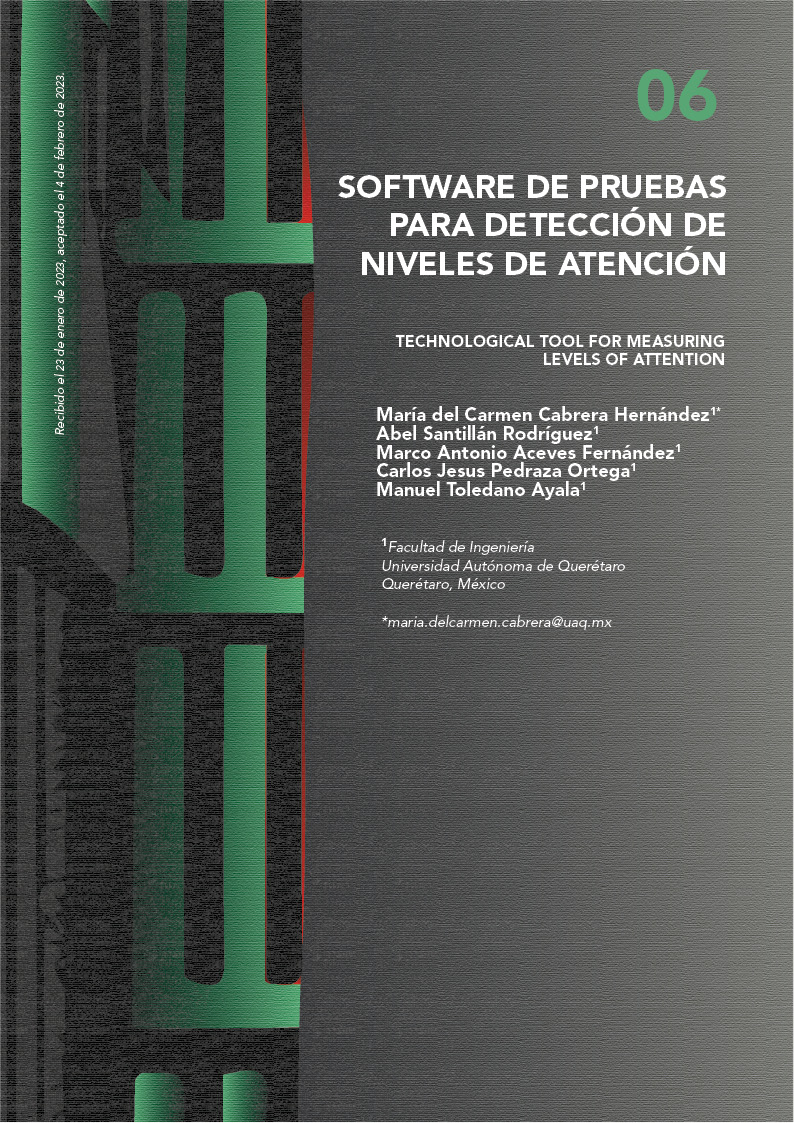Abstract
The diagnosis of attention disorders such as Attention Deficit Hyperactivity Disorder (ADHD) is the most common in school-age children, however, the figures vary depending on the children's country of residence, and in some cases, Mexico does not have official figures of how many children suffer from it, this is believed to be due to the fact that current diagnostic instruments do not take into account all the factors that influence the mechanisms of attention, for example, the concept of childhood in society could be influencing the growing number of ADHD cases, among other factors.
In this work, a proposal for a technological tool supported by various disciplines is presented that contributes to the objective of understanding how the attention process is in children to measure the levels of attention, using eye tracking tools. In conjunction with cognitive load tests and neuropsychological assessments.
References
Drechsler, R., Brem, S., Brandeis, D., Grünblatt, E., Berger, G., & Walitza, S. (2020). ADHD: Current concepts and treatments in children and adolescents. Neuropediatrics, 51(05), 315-335.
En México dos millones de personas con Trastorno de déficit de Atención. En México dos millones de personas con trastorno de déficit de atención. (n.d.). Retrieved August 27, 2022, from http://comunicacion.senado.gob.mx/index.php/informacion/grupos-parlamentarios/38806-en-mexico-dos-millones-de-personas-con-trastorno-de-deficit-de-atencion.html .
UNAM, F. (n.d.). Tdah afecta a más de un millón y medio de niños mexicanos. TDAH afecta a más de un millón y medio de niños mexicanos. Retrieved August 15, 2022, from https://www.fundacionunam.org.mx/unam-al-dia/trastorno-de-deficit-de-atencion-e-hiperactividad-afecta-a-mas-de-un-millon-y-medio-de-ninos-mexicanos/
Comunicación Social IMSS. (n.d.). Durante confinamiento, fundamental que menores con tdah realicen actividades en casa y sean Constantes Con Sus Medicamentos. Acercando El Imss Al Ciudadano. Retrieved August 14, 2022, from http://www.imss.gob.mx/prensa/archivo/202007/473
Lenartowicz, A., & Loo, S. K. (2014). Use of EEG to diagnose ADHD. Current psychiatry reports, 16(11), 1-11.
American Psychiatric Association. (2013). Diagnostic and statistical manual of mental disorders. BMC Med, 17, 133-137.
[Gualtieri, C. T., & Johnson, L. G. (2005). ADHD: Is objective diagnosis possible?. Psychiatry (Edgmont), 2(11), 44.
Narad, M. E., Garner, A. A., Peugh, J. L., Tamm, L., Antonini, T. N., Kingery, K. M., ... & Epstein, J. N. (2015). Parent–teacher agreement on ADHD symptoms across development. Psychological assessment, 27(1), 239.
Woodrow, H. (1914). The measurement of attention. The psychological monographs, 17(5), i.
Niedermeyer, E. (2005). The normal EEG of the waking adult. Electroencephalography: Basic principles, clinical applications, and related fields, 167, 155-164.
Lenartowicz, A., & Loo, S. K. (2014). Use of EEG to diagnose ADHD. Current psychiatry reports, 16(11), 498.
Weder, N. (2013). Are we there yet? Electroencephalography as a diagnostic tool for attention-deficit/hyperactivity disorder.
Conners, C. K. (1990). Manual for the Conners’ Rating Scales, Toronto: Multi-Health Systems.
Holmqvist, K., Nyström, M., Andersson, R., Dewhurst, R.,Jarodzka, H., & Van de Weijer, J. (2011). Eye tracking: A comprehensive guide to methods and measures. OUP Oxford.
McGee, R. A., Clark, S. E., & Symons, D. K. (2000). Does the Conners' continuous performance test aid in ADHD diagnosis?. Journal of Abnormal.
Lis, S., Baer, N., Stein‐en‐Nosse, C., Gallhofer, B., Sammer, G., & Kirsch, P. (2010). Objective measurement of motor activity during cognitive performance in adults with attention‐deficit/hyperactivity disorder. Acta Psychiatrica Scandinavica, 122(4), 285-294
Tseng, P. H., Cameron, I. G., Pari, G., Reynolds, J. N., Munoz, D. P., & Itti, L. (2013, jan).High-throughput classification of clinical populations from natural viewing eye movements.Journal of Neurology, 260(1), 275–284. doi: 10.1007/s00415-012-6631-2
Chandra, S., Sharma, G., Malhotra, S., Jha, D., & Mittal, A. P. (2015, December). Eye tracking based human computer interaction: Applications and their uses. In 2015 International Conference on Man and Machine Interfacing (MAMI) (pp. 1-5). IEEE.
Zambrano, J. (2018). Enseñar considerando la carga mental del aprendizaje: la teoría de la carga cognitiva. In En: IV Congreso Internacional de Ciencias Pedagógicas de Ecuador. Guayaquil.
Alderson, R. M., Kasper, L. J., Hudec, K. L., & Patros, C. H. (2013). Attention-deficit/hyperactivity disorder (ADHD) and working memory in adults: a meta-analytic review. Neuropsychology, 27(3), 287.
Sala, S. D., Laiacona, M., Trivelli,C., €: Spinnler, H. (1995). Poppelreuter-Ghent's overlapping figures test: Itssensitivity to age, and its clinical use. Archives of Clinical Neuropsychology, 10(6), 511-534.
Anstey, E. (1999). Dominó D-48 (12.a ed.). TEA Ediciones.
Thorne, C. Villegas, O, Martínez, P., Rossel, Z., 8% Twanama, W. (1985). El Test de Dominos: elaboración de baremos para la población de LimaMetropolitana (1985). Revista de Psicología, 3(2), 163-181.
Campos, A. (2009). Spatial imagery: A new measure of the visualization factor. Cognition and Personality, 29(1), 31-39.
Bodoque Osma, A. R. (2015). Detección de la condición TDAH en niños/as de la Provincia de Cuenca mediante la Escala Magallanes de Detección de Déficit de Atención (EMA-DDA).
Matute, E., Roselli, M., Ardila, A, € Ostrosky, F. (2014). ENI-2 Evaluación Neuropsicológica Infantil Manual de Aplicación. México, DF: Manual Moderno.
Alstrup, S., San Agustin, J., Tall, M, € Skovsgaard, H. (2016). https://theeyetribe.com/dev.theeyetribe.com/dev.theeyetribe.com/general/index.html, 02 de septiembre de 2022
Alstrup, S., San Agustin, J., Tall, M, € Skovsgaard, H. (2016). https://theeyetribe.com/dev.theeyetribe.com/dev.theeyetribe.com/api/index.html, 03 de mayo de 2022
Sharafi, Z., Shaffer, T., Sharif, B.,8 Guéhéneuc, Y. G. (2015, December).Eye-tracking metrics in software engineering. In 2015 Asia-Pacific Software Engineering Conference (APSEC) (pp. 96-103). IEEE.
Instituto Nacional del Derecho de autor, https://www.indautor.gob.mx, 20 de agosto de 2022

This work is licensed under a Creative Commons Attribution-NonCommercial-ShareAlike 4.0 International License.
Copyright (c) 2023 Perspectivas de la Ciencia y la Tecnología

